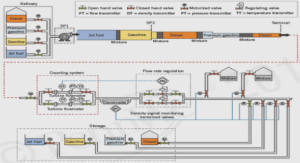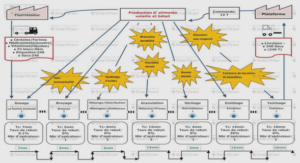Noise reduction in 2R-regeneration technique utilizing self-phase modulation and filtering
All-optical signal regeneration technique utilizing self-phase modulation in fiber and subsequent filtering was first proposed by Mamyshev [1]. This 2R-regenerator design is very attractive because of its simplicity : it only uses a fiber and an optical bandpass filter located at the output. Moreover, this technique being based on the Kerr effect, it does not suffer of any time response limitation. Since its first demonstration, this kind of regenerator has been extensively studied, both experimentally and theoretically . In some experimental studies, a noise source is superimposed on the data stream to simulate degradation of the signal by accumulation of amplified spontaneous emission (ASE) from optical amplifiers. Experimental Q-factor improvements of 1.5 dB have been reported with this regenerator [3, 4]. In these experimental studies, an input filter is usually present [2, 3, 4] but its role is not clearly identified. From a theoretical point of view, the most commonly used theoretical approach to study the Mamyshev regenerator consists of solving the nonlinear Schrodinger equation for an input ¨ pulse [6, 7, 8, 9]. Noise is generally taken into account through variations of the input pulse peak power. This method leads to a nonlinear transfer function for the regenerator. This function is known to reduce noise but does not take into account the incoherent nature of ASE noise. In reference [7], Matsumoto uses a more realistic approach of including ASE noise, but the paper is focused on performance comparison between several kind of 3R regenerators rather than on the physical understanding of the Mamyshev regenerator in the presence of incoherent noise. Interesting work has been recently proposed by Rochette et al. both theoretically and experimentally [5, 10] to explain the bit-error-rate improvement observed with this kind of regenerators. The authors argue that the regenerator needs to have different transfer functions for the signal and the noise to make BER improvement possible. However, in these papers the role of the filters is not investigated. The aim of our paper is to propose an accurate simulation of the Mamyshev regeneration technique. We demonstrate, for the first time in the best of our knowledge, that a maximum Q-factor improvement of about 2 dB is possible only if an input filter is present and suitably chosen. Our conclusion is that the Mamyshev regenerator can discriminate noise from signal only if ASE noise has been previously eliminated from the spectral region where the signal is transposed. In section 2, we present the approach which consists of taking into account the incoherent nature of ASE noise through its spectral representation. In section 3 we briefly present the principle of this self-phase-modulation-based 2R-regeneration technique. Section 4 presents the results of the simulations leading to the evaluation of the Q-factor improvement in the presence of the regenerator while section 5 is focused on the role of optical filters in this regeneration technique. 2. Relation between Q-factor and white noise In this section we give the relation between the Q-factor of a degraded data stream and its corresponding optical signal-to-noise ratio (OSNR). Our calculation technique is based on the spectral representation of white noise. We use the schematic diagram shown in Fig. 1 to model the acquisition process of an optical data stream degraded by the accumulation of amplified spontaneous emission (ASE) of erbium-doped fiber amplifiers (EDFA). The data encoder gives a 40 Gb/s random sequence of 1024 Fourier-limited gaussian pulses at 1550 nm with a full width at half maximum (FWHM) of 6.25 ps. The extinction ratio ER of the signal is defined as the ratio (in dB) between the peak power of the pulses and the background level. Let ES(t) be the function representing the magnitude of the electrical field of the optical signal in the time domain. The spectral representation E˜S(ν) is numerically calculated from ES(t) by using the discrete Fourier transform (DFT) : E˜S(ν) = 1 √N N/2−1 ∑ k=−N/2 ES kT N exp −2iπ kT N ν (1) where N is the number of points dividing the time window T. The spectral representation E˜N(ν) of ASE noise is assumed to be similar to white gaussian noise [11] and can be written, in the frequency domain, as : E˜N(ν) = Aexp(iφ(ν)), (2) where A is the magnitude of white noise. We take A constant over a frequency range B centered around the carrier frequency ν0 (see Fig. 2(a)). Quantity φ is the random phase uniformly distributed between −π and π (see Fig. 2(b)). This simple formulation allows us to take into account the incoherent nature of the spontaneous emission from optical amplifiers. The representation EN(t) of the noise in the time domain can be obtained numerically by using the inverse discrete Fourier transform (IDFT) of the spectrum. Figures 2(c) and 2(d) represent respectively the real part rN(t) and the imaginary part iN(t) of EN(t). By virtue of central limit theorem [12], both rN(t) and iN(t) can be approximated by gaussian random variables. Figures 2(e) and 2(f) represent the probability density function of rN(t) and iN(t) assuming a gaussian law with a zero mean and a variance σ2 = A2B/2T. Let us mention that this method to generate gaussian noise is similar to the method which consists to decompose the electric field in Fourier series [13]. In the frequency domain, the signal arriving at the optical bandpass filter input is written as : E˜1(ν) = E˜S(ν) +E˜N(ν). (3) Before detection, we evaluate the OSNR, defined as the ratio (in dB) between the signal power and the noise power for a given spectral range. The detection stage generally includes a bandpass optical filter to reduce noise. We use a flat-top filter represented by a fifth-order supergaussian transfer function F1(ν). The central frequency of the filter is the carrier frequency of the signal and its 3 dB-bandwidth is 150 GHz. After the filter, the signal is written as : E˜2(ν) = F1(ν)E˜1(ν). (4) The photodetector converts the optical intensity, proportional to |E2(t)| 2, into a voltage v1(t) : v1(t) = R|E2(t)| 2, (5) where R is the photodetector responsivity. In the following, R will be set to unity and we will E˜2(ν). The finite bandwidth of the electronics is taken into account through a fifth-order Bessel lowpass filter of transfer function H(ν) whose cutoff frequency is 32 GHz. After the filter, the voltage, in the frequency domain, becomes : v˜2(ν) = H(ν)v˜1(ν), (6) where ˜v1(ν) is the DFT of v1(t). To represent the eye-diagram of the signal we calculate the IDFT, v2(t), of ˜v2(ν). An example of an eye diagram is given in Fig. 3(a) for ER= 15 dB and OSNR= 20 dB/0.1nm. As expected, noise induces variations in the level of detected pulses. The corresponding intensity histogram is presented in Fig. 3(b). From this histogram we calculate the unregenerate where V1, V0, σ1 and σ0 are shown explicitly in Fig. 3(b). By varying the white noise magnitude, A, and the extinction ratio, ER, of the pulse train we can plot the evolution of the Q-factor as a function of the OSNR for different ER. The results are shown in Fig. 4.




